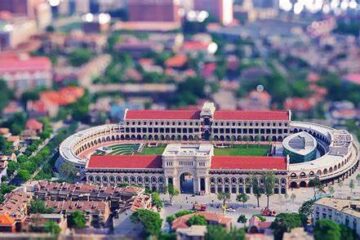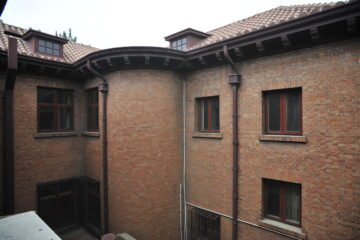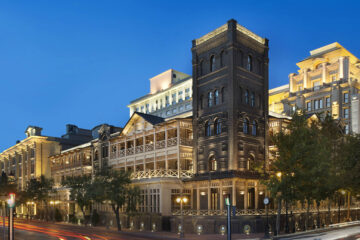Former Site of Four Banks Savings Association
建筑简介:位于解放北路,地下一层,地上三层
Building Introduction: Located on Jiefang North Road, with one underground floor and three above ground floors
小楼故事: 20世纪初,天津的外资和中外合资银行就有24家,华资银行则多达56家,解放北路更是名副其实的金融一条街,四行储蓄会便在其中。四行指的是在北洋时期,中国金融界的四个商业银行,盐业、金城、 大陆、中南。由于当时他们的主要的业务在北方,在当时被称为“北四行”。盐业、金城、大陆三大银行总部都在天津,总行位于上海的中南银行在天津设立了其首家分行。“北四行”突破传统金融的经营格局联合经营,厚集资力,互通信息,以一个整体的姿态应对外界竞争。1922年7月11日,四行在京、津、沪设立联营事务所,同年9月四行准备库成立联合发行钞票。当时北京天津聚集了大批的军阀官僚和清朝的遗老,这些人都是当时的有钱人,他们把大部分钱存入了外商银行,这对华资银行经营是一大损失,对中国的利权也是一个损失。外国人在中国成立了好多的储蓄会,上海的万国储蓄会。天津的中法储蓄会,这两个储蓄会主要是有奖储蓄,这种储蓄往往非保本,无利息,而且中奖者甚少。四行联营事务所主任吴鼎昌(盐业银行总经理)敏锐地看到了储蓄的前景,经过与其他三行的总经理接洽很快达成共识,决定设立四行储蓄会。每家各出25万银元作为基本储金,实行会员制,总会设于上海,并在天津、汉口、北京设立分会,吴鼎昌(盐业银行总经理)、周作民(金城银行总经理)、谈荔孙(大陆银行总经理)和胡笔江(中南银行总经理)这几位拥有现代经营理念的银行家,还以保本保息、期短利厚、又分红利、营业独立、会计公开为号召,不断开发新的储蓄品种,完善服务机制。五种储蓄存款,活期储金、分期储金、定期储金、长期储金、特别储金。除第一种只拿利息,后面四种年终能够分红,而且还有复利。利益丰厚,趋之必众,1923年,储蓄会开办当年存款就达到118万元。1927年,四行储蓄会的存款增长到2346万元,到1935年高达近1亿元,成为当时吸收储蓄额最高的银行,也因此有了“四行一会”的说法。此时万国储蓄会和中法储蓄会均已破产,大量资金储蓄会以再贷款的方式发放给“北四行”,在“北四行”资金紧张的时候会临时地从四行储蓄会调拨资金过来给予支援,四行储蓄会对“北四行”就起到了一个最终贷款人的作用。四行储蓄会也做一些营利性的投资,在二十年代主要就是购买有价证券,到三十年代之后,四行储蓄会也投资房地产。1931年,四行储蓄会在上海动工建造国际饭店,1932年,又在上海苏州河畔自建仓库,这就是日后闻名遐迩的四行仓库。1948年,四行储蓄会改组为联合商业储蓄信托银行。1952年12月,参加金融业全行业公私合营。作为华资银行联合经营的产物,四行储蓄会开创会员制,成功扭转了近代中国不良的储蓄风气,同时自身也发展成为知名的储蓄银行。
Xiaolou Story: At the beginning of the 20th century, there were 24 foreign-funded and Sino foreign joint venture banks in Tianjin, with as many as 56 Chinese funded banks. Jiefang North Road was truly a financial street, and the Four Banks Savings Association was among them. The Four Banks refer to the four commercial banks in the Chinese financial industry during the Beiyang period, namely Salt Industry, Jincheng, Mainland China, and Zhongnan. Due to their main business being in the north at that time, they were known as the ‘Northern Four Rows’. The headquarters of the three major banks, Salt Industry, Jincheng, and Mainland China, are all located in Tianjin. Central South Bank, headquartered in Shanghai, has established its first branch in Tianjin. The “Northern Four Banks” break through the traditional financial business pattern of joint operation, gather resources, exchange information, and respond to external competition as a whole. On July 11, 1922, Four Banks established joint venture offices in Beijing, Tianjin, and Shanghai, and in September of the same year, Four Banks prepared to establish a joint issuance of banknotes. At that time, Beijing and Tianjin gathered a large number of warlords, bureaucrats, and remnants of the Qing Dynasty, all of whom were wealthy people at that time. They deposited most of their money into foreign banks, which was a great loss to the operation of Chinese banks and a loss to China’s interests. Foreigners have set up many savings associations in China, and the Shanghai World Savings Association. The Sino French Savings Association in Tianjin mainly offers prize savings, which are often non guaranteed, interest free, and have very few winners. Wu Dingchang, Director of the Four Banks Joint Venture Office (General Manager of Salt Industry Bank), keenly saw the prospects of savings and quickly reached a consensus with the general managers of the other three banks, deciding to establish the Four Banks Savings Association. Each household contributes 250000 silver dollars as their basic savings, implementing a membership system. The association is located in Shanghai and branches are established in Tianjin, Hankou, and Beijing. Wu Dingchang (General Manager of Salt Industry Bank), Zhou Zuomin (General Manager of Jincheng Bank), Tan Lisun (General Manager of Mainland Bank), and Hu Bijiang (General Manager of Central South Bank), several bankers with modern business concepts, continue to develop new savings products and improve service mechanisms with the call for principal and interest protection, short term interest, dividend distribution, independent business, and open accounting. There are five types of savings deposits: current savings, installment savings, fixed-term savings, long-term savings, and special savings. Except for the first type that only receives interest, the latter four types can receive dividends at the end of the year, and there is also compound interest. The benefits are abundant and the trend is inevitable. In 1923, when the savings association was established, the deposit reached 1.18 million yuan. In 1927, the deposits of the Four Banks Savings Association increased to 23.46 million yuan, and by 1935, it had reached nearly 100 million yuan, becoming the bank with the highest amount of savings at that time, hence the saying “Four Banks, One Association”. At this time, both the International Savings Association and the Sino French Savings Association have gone bankrupt, and a large amount of savings funds will be disbursed to the “Northern Fourth Bank” in the form of refinancing. When the “Northern Fourth Bank” is in a tight financial situation, funds will be temporarily transferred from the Fourth Bank Savings Association to provide support, and the Fourth Bank Savings Association will play a role as the ultimate lender to the “Northern Fourth Bank”. The Four Banks Savings Association also made some profitable investments, mainly purchasing securities in the 1920s, and after the 1930s, the Four Banks Savings Association also invested in real estate. In 1931, Sihang Savings Association started construction of the International Hotel in Shanghai, and in 1932, they built their own warehouse on the Suzhou River in Shanghai, which became the famous Sihang Warehouse in the future. In 1948, the Four Banks Savings Association was reorganized into the United Commercial Savings Trust Bank. In December 1952, participated in the public-private partnership of the entire financial industry. As a product of the joint operation of Chinese funded banks, the Four Banks Savings Association pioneered a membership system, successfully reversing the unhealthy savings atmosphere in modern China, and also developed into a well-known savings bank.



0 条评论